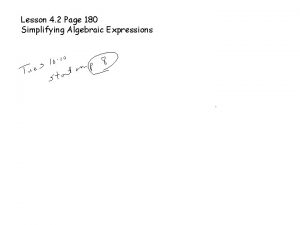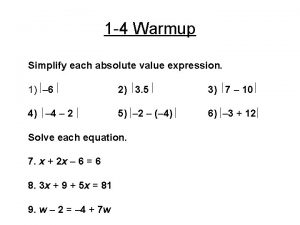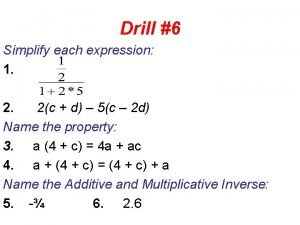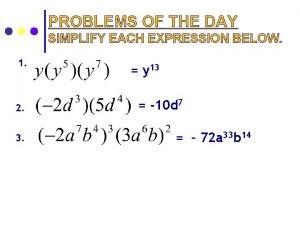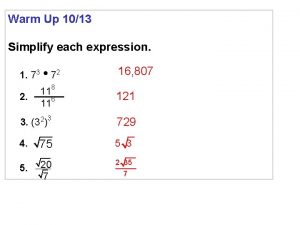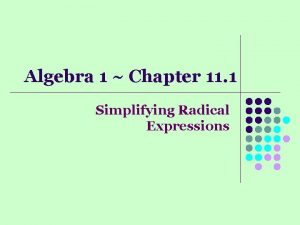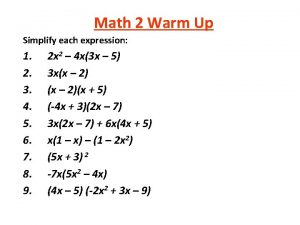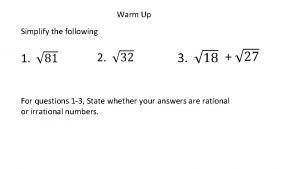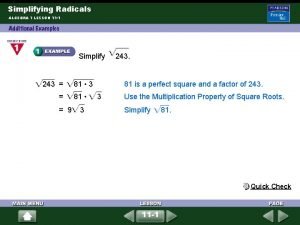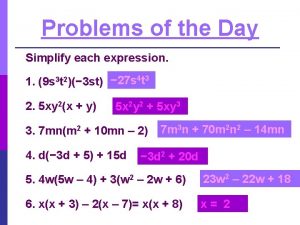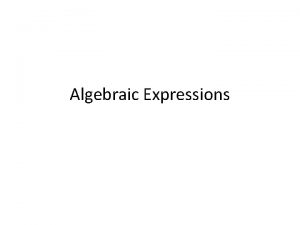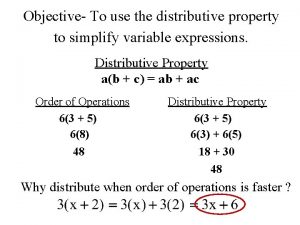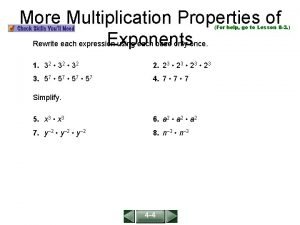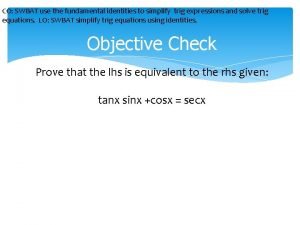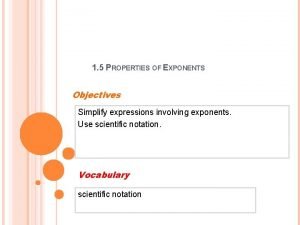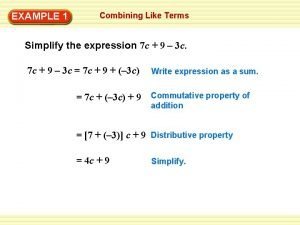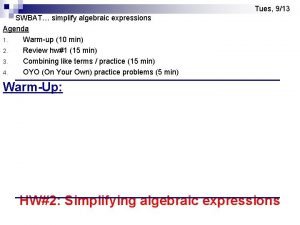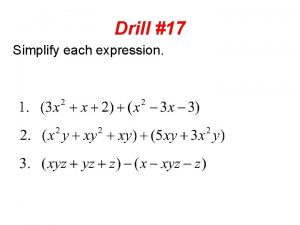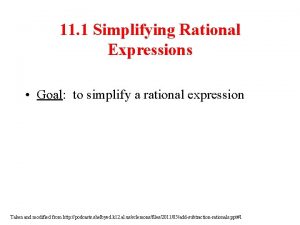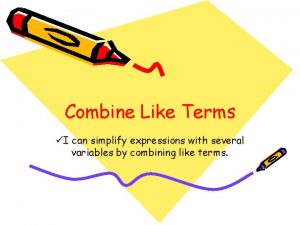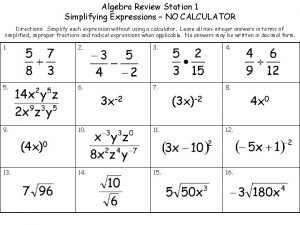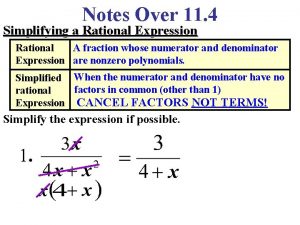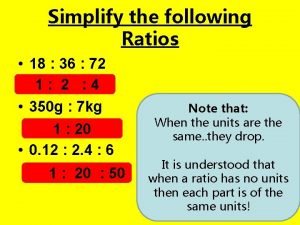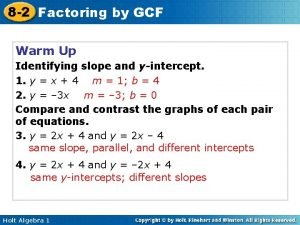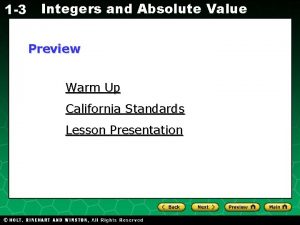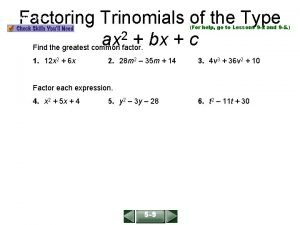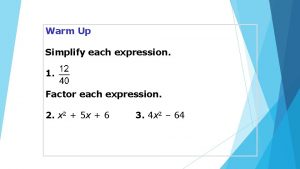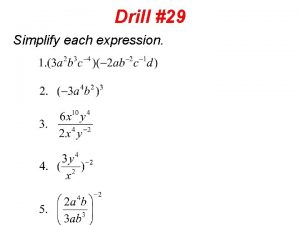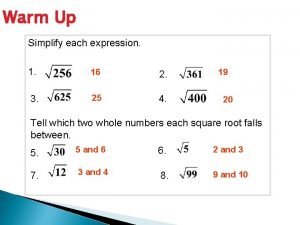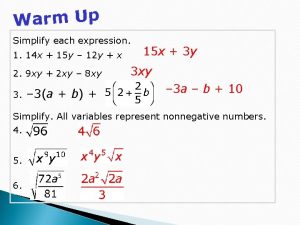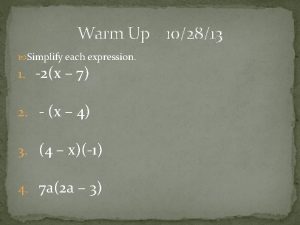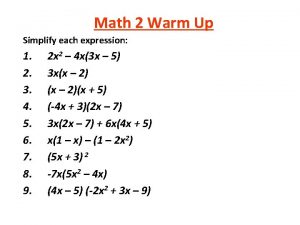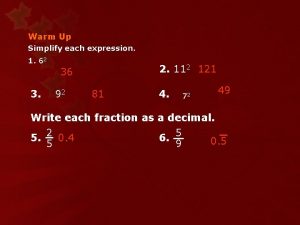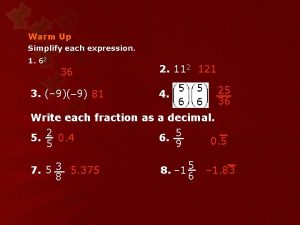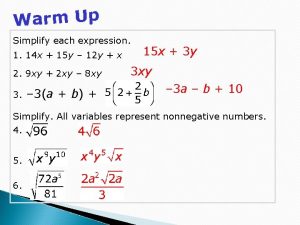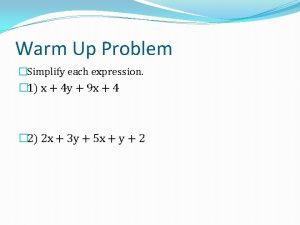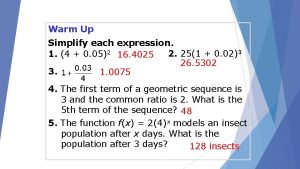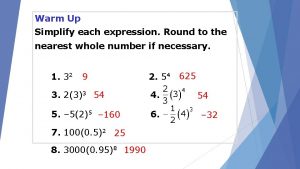Warm Up Simplify each expression 1 3 x


































- Slides: 34

Warm Up Simplify each expression. 1. 3 x + 2 y – 5 x – 2 y 2. 5(x – y) + 2 x + 5 y 3. 4 y + 6 x – 3(y + 2 x) 4. 2 y – 4 x – 2(4 y – 2 x) Write the least common multiple. 5. 3 and 6 6. 4 and 10 7. 6 and 8 8. 2 and 5

Objectives Solve systems of linear equations in two variables by elimination. Compare and choose an appropriate method for solving systems of linear equations.

Another method for solving systems of equations is elimination. Like substitution, the goal of elimination is to get one equation that has only one variable. To do this by elimination, you add the two equations in the system together. Remember that an equation stays balanced if you add equal amounts to both sides. So, if 5 x + 2 y = 1, you can add 5 x + 2 y to one side of an equation and 1 to the other side and the balance is maintained.

Since – 2 y and 2 y have opposite coefficients, the yterm is eliminated. The result is one equation that has only one variable: 6 x = – 18. When you use the elimination method to solve a system of linear equations, align all like terms in the equations. Then determine whether any like terms can be eliminated because they have opposite coefficients.

Solving Systems of Equations by Elimination Step 1 Write the system so that like terms are aligned. Step 2 Eliminate one of the variables and solve for the other variable. Step 3 Substitute the value of the variable into one of the original equations and solve for the other variable. Step 4 Write the answers from Steps 2 and 3 as an ordered pair, (x, y), and check.

Later in this lesson you will learn how to multiply one or more equations by a number in order to produce opposites that can be eliminated.

Example 1: Elimination Using Addition Solve 3 x – 4 y = 10 by elimination. x + 4 y = – 2 Step 1 Step 2 3 x – 4 y = 10 x + 4 y = – 2 4 x + 0 = 8 4 x = 8 4 4 x=2 Write the system so that like terms are aligned. Add the equations to eliminate the y-terms. Simplify and solve for x. Divide both sides by 4.

Example 1 Continued Step 3 x + 4 y = – 2 2 + 4 y = – 2 – 2 4 y = – 4 4 y – 4 4 4 y = – 1 Step 4 (2, – 1) Write one of the original equations. Substitute 2 for x. Subtract 2 from both sides. Divide both sides by 4. Write the solution as an ordered pair.

Check It Out! Example 1 Solve y + 3 x = – 2 by elimination. 2 y – 3 x = 14 y + 3 x = – 2 2 y – 3 x = 14 Step 2 3 y + 0 = 12 3 y = 12 Step 1 Write the system so that like terms are aligned. Add the equations to eliminate the x-terms. Simplify and solve for y. Divide both sides by 3. y=4

Check It Out! Example 1 Continued Step 3 y + 3 x = – 2 4 + 3 x = – 2 – 4 3 x = – 6 3 3 x = – 2 Step 4 (– 2, 4) Write one of the original equations. Substitute 4 for y. Subtract 4 from both sides. Divide both sides by 3. Write the solution as an ordered pair.

When two equations each contain the same term, you can subtract one equation from the other to solve the system. To subtract an equation add the opposite of each term.

Example 2: Elimination Using Subtraction Solve 2 x + y = – 5 by elimination. 2 x – 5 y = 13 Step 1 2 x + y = – 5 –(2 x – 5 y = 13) 2 x + y = – 5 – 2 x + 5 y = – 13 Step 2 0 + 6 y = – 18 y = – 3 Add the opposite of each term in the second equation. Eliminate the x term. Simplify and solve for y.

Example 2 Continued Step 3 2 x + y = – 5 2 x + (– 3) = – 5 2 x – 3 = – 5 +3 +3 Write one of the original equations. Substitute – 3 for y. 2 x Simplify and solve for x. = – 2 x = – 1 Step 4 (– 1, – 3) Add 3 to both sides. Write the solution as an ordered pair.

Remember! Remember to check by substituting your answer into both original equations.

Check It Out! Example 2 Solve Step 1 Step 2 3 x + 3 y = 15 by elimination. – 2 x + 3 y = – 5 3 x + 3 y = 15 –(– 2 x + 3 y = – 5) 3 x + 3 y = 15 + 2 x – 3 y = +5 5 x + 0 = 20 5 x = 20 x=4 Add the opposite of each term in the second equation. Eliminate the y term. Simplify and solve for x.

Check It Out! Example 2 Continued Step 3 3 x + 3 y = 15 3(4) + 3 y = 15 12 + 3 y = 15 – 12 3 y = 3 y=1 Step 4 (4, 1) Write one of the original equations. Substitute 4 for x. Subtract 12 from both sides. Simplify and solve for y. Write the solution as an ordered pair.

In some cases, you will first need to multiply one or both of the equations by a number so that one variable has opposite coefficients. This will be the new Step 1.

Example 3 A: Elimination Using Multiplication First Solve the system by elimination. x + 2 y = 11 – 3 x + y = – 5 Step 1 Step 2 x + 2 y = 11 – 2(– 3 x + y = – 5) x + 2 y = 11 +(6 x – 2 y = +10) 7 x + 0 = 21 7 x = 21 x=3 Multiply each term in the second equation by – 2 to get opposite y-coefficients. Add the new equation to the first equation. Simplify and solve for x.

Example 3 A Continued Step 3 x + 2 y = 11 3 + 2 y = 11 – 3 2 y = 8 y=4 Step 4 (3, 4) Write one of the original equations. Substitute 3 for x. Subtract 3 from each side. Simplify and solve for y. Write the solution as an ordered pair.

Example 3 B: Elimination Using Multiplication First Solve the system by elimination. – 5 x + 2 y = 32 2 x + 3 y = 10 Step 1 2(– 5 x + 2 y = 32) 5(2 x + 3 y = 10) – 10 x + 4 y = 64 Step 2 Multiply the first equation by 2 and the second equation by 5 to get opposite x-coefficients +(10 x + 15 y = 50) Add the new equations. 19 y = 114 y=6 Simplify and solve for y.

Example 3 B Continued Step 3 2 x + 3 y = 10 2 x + 3(6) = 10 2 x + 18 = 10 – 18 Step 4 2 x = – 8 x = – 4 (– 4, 6) Write one of the original equations. Substitute 6 for y. Subtract 18 from both sides. Simplify and solve for x. Write the solution as an ordered pair.

Check It Out! Example 3 a Solve the system by elimination. 3 x + 2 y = 6 –x + y = – 2 Step 1 3 x + 2 y = 6 3(–x + y = – 2) 3 x + 2 y = 6 +(– 3 x + 3 y = – 6) 0 Step 2 + 5 y = 0 y=0 Multiply each term in the second equation by 3 to get opposite x-coefficients. Add the new equation to the first equation. Simplify and solve for y.

Check It Out! Example 3 a Continued Step 3 –x + y = – 2 –x + 3(0) = – 2 –x + 0 = – 2 Write one of the original equations. Substitute 0 for y. Simplify and solve for x. –x = – 2 x=2 Step 4 (2, 0) Write the solution as an ordered pair.

Check It Out! Example 3 b Solve the system by elimination. 2 x + 5 y = 26 – 3 x – 4 y = – 25 Step 1 Step 2 3(2 x + 5 y = 26) +(2)(– 3 x – 4 y = – 25) Multiply the first equation by 3 and the second equation by 2 to get opposite x-coefficients 6 x + 15 y = 78 +(– 6 x – 8 y = – 50) Add the new equations. 0 + 7 y = 28 Simplify and solve for y. y =4

Check It Out! Example 3 b Continued Step 3 2 x + 5 y = 26 2 x + 5(4) = 26 2 x + 20 = 26 – 20 2 X = 6 x=3 Step 4 (3, 4) Write one of the original equations. Substitute 4 for y. Subtract 20 from both sides. Simplify and solve for x. Write the solution as an ordered pair.

Example 4: Application Paige has $7. 75 to buy 12 sheets of felt and card stock for her scrapbook. The felt costs $0. 50 per sheet, and the card stock costs $0. 75 per sheet. How many sheets of each can Paige buy? Write a system. Use f for the number of felt sheets and c for the number of card stock sheets. 0. 50 f + 0. 75 c = 7. 75 f + c = 12 The cost of felt and card stock totals $7. 75. The total number of sheets is 12.

Example 4 Continued Step 1 0. 50 f + 0. 75 c = 7. 75 Multiply the second equation by – 0. 50 to get + (– 0. 50)(f + c) = 12 opposite f-coefficients. 0. 50 f + 0. 75 c = 7. 75 Add this equation to the + (– 0. 50 f – 0. 50 c = – 6) first equation to 0. 25 c = 1. 75 Step 2 eliminate the f-term. Simplify and solve for c. c=7 Step 3 f + c = 12 f + 7 = 12 – 7 f = 5 Write one of the original equations. Substitute 7 for c. Subtract 7 from both sides.

Example 4 Continued (7, 5) Write the solution as an ordered pair. Paige can buy 7 sheets of card stock and 5 sheets of felt. Step 4

Check It Out! Example 4 What if…? Sally spent $14. 85 to buy 13 flowers. She bought lilies, which cost $1. 25 each, and tulips, which cost $0. 90 each. How many of each flower did Sally buy? Write a system. Use l for the number of lilies and t for the number of tulips. 1. 25 l + 0. 90 t = 14. 85 l + t = 13 The cost of lilies and tulips totals $14. 85. The total number of flowers is 13.

Check It Out! Example 4 Continued Step 1 1. 25 l +. 90 t = 14. 85 + (–. 90)(l + t) = 13 Multiply the second equation by – 0. 90 to get opposite t-coefficients. 1. 25 l + 0. 90 t = 14. 85 + (– 0. 90 l – 0. 90 t = – 11. 70) Add this equation to the 0. 35 l = 3. 15 first equation to eliminate the t-term. Step 2 Simplify and solve for l. l=9

Check It Out! Example 4 Continued Step 3 Step 4 l + t = 13 9 + t = 13 – 9 t = 4 (9, 4) Write one of the original equations. Substitute 9 for l. Subtract 9 from both sides. Write the solution as an ordered pair. Sally bought 9 lilies and 4 tulips.

All systems can be solved in more than one way. For some systems, some methods may be better than others.


Lesson Quiz Solve each system by elimination. 1. 2 x + y = 25 3 y = 2 x – 13 2. – 3 x + 4 y = – 18 x = – 2 y – 4 (2, – 3) 3. – 2 x + 3 y = – 15 3 x + 2 y = – 23 (– 3, – 7) (11, 3) 4. Harlan has $44 to buy 7 pairs of socks. Athletic socks cost $5 per pair. Dress socks cost $8 per pair. How many pairs of each can Harlan buy? 4 pairs of athletic socks and 3 pairs of dress socks
 Lesson 4 work with algebraic expressions
Lesson 4 work with algebraic expressions Simplify each expression by combining like terms
Simplify each expression by combining like terms How to simplify absolute value expressions
How to simplify absolute value expressions Constant number example
Constant number example Simplify each expression and then arrange them in
Simplify each expression and then arrange them in Simplify each expression.
Simplify each expression. 11-1 simplifying radical expressions answers
11-1 simplifying radical expressions answers Simplify each expression
Simplify each expression For questions 1–2, simplify each expression.
For questions 1–2, simplify each expression. Practice 11-1 simplifying radical answers
Practice 11-1 simplifying radical answers Simplify each expression
Simplify each expression Simplify each expression
Simplify each expression Simplify expressions
Simplify expressions Use the properties of exponents to rewrite each expression
Use the properties of exponents to rewrite each expression Use the fundamental identities to simplify the expression
Use the fundamental identities to simplify the expression Simplify the expression using properties of exponents
Simplify the expression using properties of exponents Examples of combining like terms
Examples of combining like terms Simplify the following trigonometric expression
Simplify the following trigonometric expression Simplify the expression
Simplify the expression Use the distributive property to simplify the expression
Use the distributive property to simplify the expression Boolean expression
Boolean expression Simplify the expression.
Simplify the expression. How to simplify rational expressions
How to simplify rational expressions Simplify the expression
Simplify the expression Simplify rational expression
Simplify rational expression Simplify the expression by combining like terms
Simplify the expression by combining like terms Simplifying expressions calculator
Simplifying expressions calculator 11-4 multiplying and dividing rational expressions
11-4 multiplying and dividing rational expressions K map
K map Simplify each of the following ratios
Simplify each of the following ratios Quadratic formula examples
Quadratic formula examples 8-2 factoring by gcf
8-2 factoring by gcf Evaluate each expression integers
Evaluate each expression integers Factoring each expression
Factoring each expression Factoring trinomials
Factoring trinomials
